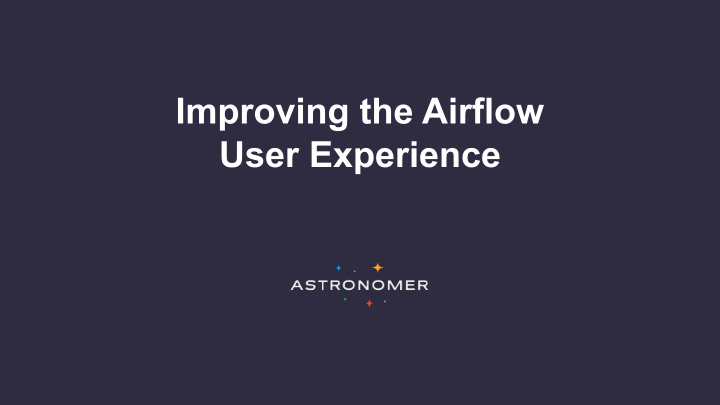



Improving the Airflow User Experience
Speakers Ry Walker Viraj Parekh Maxime Beauchemin Founder/CTO at Astronomer Head of Field Engineering Founder/CEO of Preset, Creator of at Astronomer Apache Airflow and Apache Superset @rywalker @vmpvmp94 @mistercrunch
About Astronomer 100+ Astronomer is focused on helping Enterprise customers around the world organizations adopt Apache Airflow, the open-source standard for data pipeline 4 of top 7 orchestration. Airflow committers are Astronomer advisors or employees Products Investors Locations San Francisco London New York Cincinnati Hyderabad
7 Stages of Airflow User Experience Security / Author Build Test Deploy Run Monitor Governance
Security / Author Build Test Deploy Run Monitor Governance Current LDAP authentication Kerberos (w/ some operators) Fernet key encryption External secrets backend CVE Mitigations RBAC ● Astronomer has multi-tenant RBAC solution built in
Security / Author Build Test Deploy Run Monitor Governance Current Future LDAP authentication Data lineage Kerberos (w/ some operators) Audit logs Fernet key encryption Integration with external identity providers (Auth0, Okta, Ping, SAML) External secrets backend CVE Mitigations RBAC ● Astronomer has multi-tenant RBAC solution built in
Security / Author Build Test Deploy Run Monitor Governance Current Your Text Editor + Python environment Astronomer CLI Community Projects - DagFactory (DevotedHealth) - Airflow DAG Creation Manager Plugin - Kedro
git pull code .
https://github.com/ajbosco/dag-factory
Define a DAG with YAML
Define a DAG with YAML Parse the YAML
….and you have a DAG!
https://github.com/lattebank/airflow-dag-creation-manager-plugin
Create and manage DAGS directly from the UI
Security / Author Build Test Deploy Run Monitor Governance Current Future Your Text Editor + Python DAGs from Notebooks environment Scheduling SQL query from UI Astronomer CLI DAG Generator from standard Community Projects templates - DagFactory (DevotedHealth) - Airflow DAG Creation Manager Plugin - Kedro
Security / Author Build Test Deploy Run Monitor Governance Current Most users git-sync DAGs, add prod dependencies manually Official Community Docker Image Astronomer is Docker-centric ● Define dependencies (both (Python packages + system-level packages) directly in your code project ● Run the image locally with Docker ● Reduces devOps workload, since data engineers trial and error dependencies locally ● Can run the whole image through CVE testing
Security / Author Build Test Deploy Run Monitor Governance Current No standardization around DAG unit testing Adhoc testing for different data scenarios Community Projects: ● Raybeam Status Plugin ● Great Expectations Pipeline Tutorial
https://github.com/Raybeam/rb_status_plugin
Is the data ready?
Schedule data quality tasks as reports
Keep stakeholders aware of data quality
Keep stakeholders aware of data quality Hooks into existing Airflow functionality
Security / Author Build Test Deploy Run Monitor Governance Current Future No standardization around DAG unit Data awareness? testing Standardized best practices for DAG Adhoc testing for different data unit testing scenarios Additional automated testing of Community Projects: Hooks and Operators ● Raybeam Status Plugin ● Great Expectations Pipeline Tutorial
Security / Author Build Test Deploy Run Monitor Governance Current Most Airflow deployments are pets, not cattle — manually deployed “Guess and check” for configurations The Astronomer Way ● Use Kubernetes! ● Airflow now has an official Helm chart ● Astronomer platform makes it easy to CRUD Airflow deployments
Official Helm Chart for Apache Airflow This chart will bootstrap an Airflow deployment on a Kubernetes cluster using the Helm package manager. Prerequisites ● Kubernetes 1.12+ cluster ● Helm 2.11+ or Helm 3.0+ ● PV provisioner support in the underlying infrastructure ## from the chart directory of the airflow repo kubectl create namespace airflow helm repo add stable https://kubernetes-charts.storage.googleapis.com helm dep update helm install airflow . --namespace airflow
uid images.redis.pullPolicy workers.terminationGracePeriodSeconds gid images.pgbouncer.repository workers.safeToEvict nodeSelector images.pgbouncer.tag scheduler.podDisruptionBudget.enabled affinity images.pgbouncer.pullPolicy scheduler.podDisruptionBudget.config.maxUnavailable tolerations images.pgbouncerExporter.repository scheduler.resources.limits.cpu labels images.pgbouncerExporter.tag scheduler.resources.limits.memory privateRegistry.enabled images.pgbouncerExporter.pullPolicy scheduler.resources.requests.cpu privateRegistry.repository env scheduler.resources.requests.memory networkPolicies.enabled secret scheduler.airflowLocalSettings airflowHome data.metadataSecretName scheduler.safeToEvict rbacEnabled data.resultBackendSecretName webserver.livenessProbe.initialDelaySeconds executor data.metadataConection webserver.livenessProbe.timeoutSeconds allowPodLaunching data.resultBackendConnection webserver.livenessProbe.failureThreshold defaultAirflowRepository fernetKey webserver.livenessProbe.periodSeconds defaultAirflowTag fernetKeySecretName webserver.readinessProbe.initialDelaySeconds images.airflow.repository workers.replicas webserver.readinessProbe.timeoutSeconds images.airflow.tag workers.keda.enabled webserver.readinessProbe.failureThreshold images.airflow.pullPolicy workers.keda.pollingInverval webserver.readinessProbe.periodSeconds images.flower.repository workers.keda.cooldownPeriod webserver.replicas images.flower.tag workers.keda.maxReplicaCount webserver.resources.limits.cpu images.flower.pullPolicy workers.persistence.enabled webserver.resources.limits.memory images.statsd.repository workers.persistence.size webserver.resources.requests.cpu images.statsd.tag workers.persistence.storageClassName webserver.resources.requests.memory images.statsd.pullPolicy workers.resources.limits.cpu webserver.defaultUser images.redis.repository workers.resources.limits.memory dags.persistence.* images.redis.tag workers.resources.requests.cpu dags.gitSync.* workers.resources.requests.memory
helm install airflow-ry . --namespace airflow-ry NAME: airflow-ry LAST DEPLOYED: Wed Jul 8 20:10:29 2020 NAMESPACE: airflow-ry STATUS: deployed REVISION: 1 You can now access your dashboard(s) by executing the following command(s) and visiting the corresponding port at localhost in your browser: Airflow dashboard: kubectl port-forward svc/airflow-ry-webserver 8080:8080 --namespace airflow kubectl get pods --namespace airflow-ry NAME READY STATUS RESTARTS AGE airflow-ry-postgresql-0 1/1 Running 0 6m45s airflow-ry-scheduler-78757cd557-t8zdn 2/2 Running 0 6m45s airflow-ry-statsd-5c889cc6b6-jxhzw 1/1 Running 0 6m45s airflow-ry-webserver-59d79b9955-7sgp5 1/1 Running 0 6m45s
astro deployment create test-deployment --executor celery NAME DEPLOYMENT NAME ASTRO DEPLOYMENT ID test-deployment theoretical-element-5806 0.15.2 ckce1ssco4uf90j16a5adkel7 Successfully created deployment with Celery executor. Deployment can be accessed at the following URLs Airflow Dashboard: https://deployments.astronomer.io/theoretical-element-5806/airflow Flower Dashboard: https://deployments.astronomer.io/theoretical-element-5806/flower astro deployment delete ckce1ssco4uf90j16a5adkel7 Successfully deleted deployment
airflow.cfg name Environment Variable Default Value parallelism AIRFLOW__CORE__PARALLELISM 32 dag_concurrency AIRFLOW__CORE__DAG_CONCURRENCY 16 worker_concurrency AIRFLOW__CELERY__WORKER_CONCURRENCY 16 max_threads AIRFLOW__SCHEDULER__MAX_THREADS 2 parallelism is the max number of task instances that can run concurrently on airflow. This means that across all running DAGs, no more than 32 tasks will run at one time. dag_concurrency is the number of task instances allowed to run concurrently within a specific dag . In other words, you could have 2 DAGs running 16 tasks each in parallel, but a single DAG with 50 tasks would also only run 16 tasks - not 32 These are the main two settings that can be tweaked to fix the common "Why are more tasks not running even after I add workers?" worker_concurrency is related, but it determines how many tasks a single worker can process. So, if you have 4 workers running at a worker concurrency of 16, you could process up to 64 tasks at once. Configured with the defaults above, however, only 32 would actually run in parallel. (and only 16 if all tasks are in the same DAG) Pro tip: If you increase worker_concurrency, make sure your worker has enough resources to handle the load. You may need to increase CPU and/or memory on your workers. Note: This setting only impacts the CeleryExecutor
Recommend
More recommend